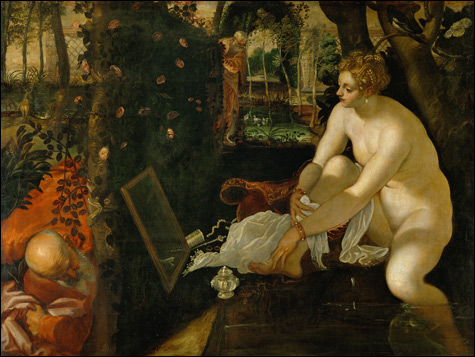
SUSANNAH AND THE ELDERS: Is the light that seems to impregnate Susannah streaming down from Heaven, or from Tintoretto? |
In a Bon Appétit essay a few years back, Alan Richman wrote, "There are two kinds of people in America: those who like Florence and those who like Venice." Boston has always been in the Florence camp. Florence is the Roman Empire and sun and bright light and primary colors and the primacy of the intellect. Not to mention Machiavelli, at whose feet Boston politicians seem to have learned their trade. Venice is the Orient and water and fog and refracted light and shifting colors and the pleasures of the body. In place of Machiavelli, it has Casanova.The Venetian palazzo that Isabella Stewart Gardner built for herself and that is now the Gardner Museum is an island of Venice in Florentine Boston. But it'll have company starting this Sunday, when the Museum of Fine Arts opens "Titian, Tintoretto, Veronese: Rivals in Renaissance Venice," a blockbuster show with 19 Titians, 18 Tintorettos, and 17 Veroneses. The MFA itself owns just two Titians (attribution of both in question), one Tintoretto (some of it by his workshop), and a few Veroneses, so landing this extravaganza, whose only other venue is the Louvre in Paris, was a coup.
The show's subtitle has overtones of "Three Venetian Artists," Venetian Idol, and a WAF (World Artists' Federation) smackdown, but the actual spin of "Titian, Tintoretto, Veronese" is that the trio — Titian born around 1488, Tintoretto in 1518, Veronese in 1528 — competed with one another for commissions, and that this rivalry affected the way their styles evolved. At the dawn of the 16th century, Italian painting began to move away from tempera and wood panel and toward oil and canvas, and there was a passing of the torch from Tuscany (which in the 15th century had spawned Fra Angelico, Masaccio, Piero della Francesca, Botticelli, Leonardo, and Michelangelo, to name a very few) to the Veneto, to Gentile and Giovanni Bellini and Giorgione. The relatively flat, spiritual, Neo-Platonic affect of the Florentine Quattrocento, with its firm line and religious certainties, gave way to the Venetian Cinquecento's play of water and light and texture, the sensuous luxury of oil paint, its broken line on canvas, and the sensuous luxury of the flesh — mostly women's.
At the MFA, "Titian, Tintoretto, Veronese" is set up as a series of face-offs involving two or three paintings, across five rooms: "New Rivals," "Sacred Themes," "Mythological Nudes" (framed by a pair of red damask curtains to suggest a bedroom), "Portraiture," and "Late Styles." There's a Supper at Emmaus from each artist, and a St. Jerome in the Wilderness, and the Tarquin and Lucretias from Titian and Tintoretto are juxtaposed with Veronese's Perseus and Andromeda. It's dizzying: curator Frederick Ilchman has snagged an improbable number of pairs and trios from the world's famous (and not so famous) museums.
The drawback of this approach — which is what the Gardner Museum has been doing in its special-exhibitions room — is that you don't get an overview of the individual artists. And the show catalogue defers to the primacy of the intellect. Aretino's "female pope among cities," Wordsworth's "eldest child of Liberty," Byron's "The revel of the earth, the masque of Italy," and Henry James's breathing of "conscious, reluctant mortality" are conspicuous by their absence — not to mention the magic of Carnival, the rhythm of water lapping against gondolas, and the seductive sibilants of Santazustina and Sanzanipolo.
But it's a stupefying collection. And here's an attempt at that overview.
Titian
His name may conjure opulent (by Florentine standards) nudes, but Titian's actual range is off the charts: Sacred and Profane Love, the Frari Assumption of the Virgin, Bacchus and Ariadne, The Presentation of the Virgin, Venus of Urbino, Pope Paul III and His Grandsons Alessandro and Ottavio Farnese, Charles V at Mühlberg, Europa, The Flaying of Marsyas, The Martyrdom of St. Lawrence, the late Crown of Thorns, the late Pietà, and at least a couple of Self-Portraits. You'll find only one of these in Boston, and it won't be at the MFA: Europa, America's outstanding Titian, will be holding down its usual spot high on a wall in the third-floor Italian room across the street at the Gardner Museum. Ilchman explains that he didn't want to ask the Gardner for it unless he had a good pairing; the obvious candidate was Veronese's The Rape of Europa (where it's party time for Europa, her friends, and Jove the bull) at the Doge's Palace in Venice, but the curator there was reluctant to let this behemoth (it's nearly 8x10) go.